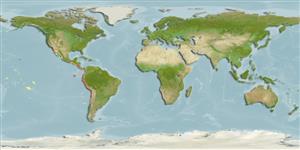Environment: milieu / climate zone / depth range / distribution range
Écologie
marin benthopélagique; profondeur 60 - 180 m (Ref. 5530). Tropical; 31°N - 34°S
East Pacific: Costa Rica, Colombia to extreme south of Chile. Records from Juan Fernández Is. are incidental (Ref. 89357). Records from Baja California, Mexico, Nicaragua and the Galapagos Islands are doubtful.
Length at first maturity / Taille / Poids / Âge
Maturity: Lm 26.9 range ? - ? cm
Max length : 54.5 cm TL mâle / non sexé; (Ref. 53696); poids max. publié: 2.5 kg (Ref. 53696)
Occurs in schools (Ref. 5530). Known from a temperature range of 14-16 °C (Ref. 9098). Also caught with trammel nets (Ref. 9342). An appreciated food fish in Peru (Ref. 9342).
Life cycle and mating behavior
Maturité | Reproduction | Frai | Œufs | Fécondité | Larves
Also Ref. 103751.
Heemstra, P.C., 1995. Serranidae. Meros, serranos, guasetas, enjambres, baquetas, indios, loros, gallinas, cabrillas, garropas. p. 1565-1613. In W. Fischer, F. Krupp, W. Schneider, C. Sommer, K.E. Carpenter and V. Niem (eds.) Guia FAO para Identification de Especies para lo Fines de la Pesca. Pacifico Centro-Oriental. 3 Vols. FAO, Rome. (Ref. 9342)
Statut dans la liste rouge de l'IUCN (Ref. 130435: Version 2024-1)
Menace pour l'homme
Harmless
Utilisations par l'homme
Pêcheries: commercial
Outils
Articles particuliers
Télécharger en XML
Sources Internet
Estimates based on models
Preferred temperature (Ref.
123201): 11.5 - 17.1, mean 15 °C (based on 41 cells).
Phylogenetic diversity index (Ref.
82804): PD
50 = 0.5020 [Uniqueness, from 0.5 = low to 2.0 = high].
Bayesian length-weight: a=0.01047 (0.00557 - 0.01970), b=3.05 (2.89 - 3.21), in cm total length, based on LWR estimates for this species & Genus-body shape (Ref.
93245).
Niveau trophique (Ref.
69278): 4.1 ±0.5 se; based on diet studies.
Résilience (Ref.
120179): Milieu, temps minimum de doublement de population : 1,4 à 4,4 années (tm=2).
Fishing Vulnerability (Ref.
59153): Moderate vulnerability (42 of 100).
Climate Vulnerability (Ref.
125649): Moderate vulnerability (40 of 100).
Nutrients (Ref.
124155): Calcium = 73.7 [31.6, 146.4] mg/100g; Iron = 0.827 [0.437, 1.547] mg/100g; Protein = 17.2 [15.4, 18.9] %; Omega3 = 0.259 [0.147, 0.451] g/100g; Selenium = 71.9 [38.6, 155.3] μg/100g; VitaminA = 46.2 [16.4, 151.5] μg/100g; Zinc = 0.915 [0.631, 1.330] mg/100g (wet weight);
